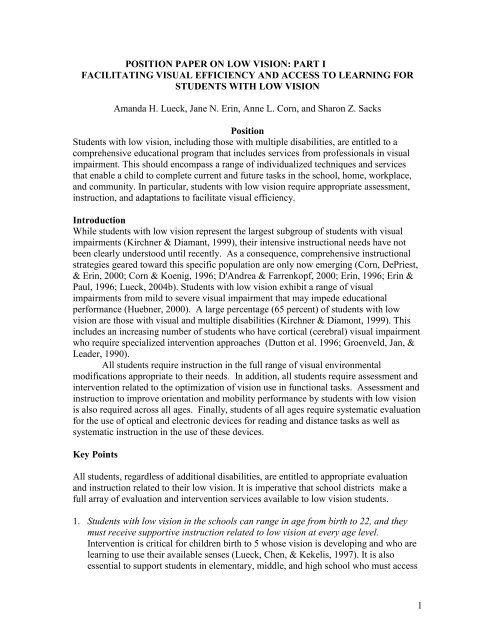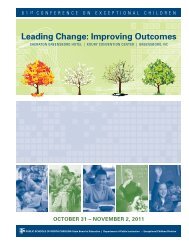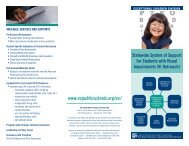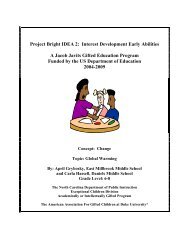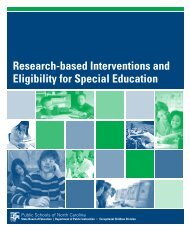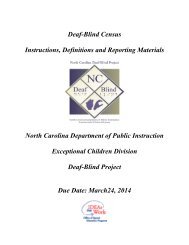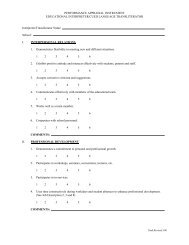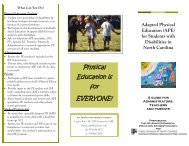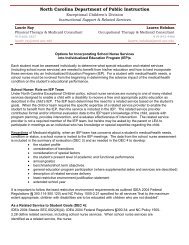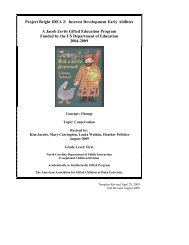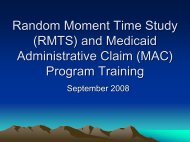Facilitating Visual Efficiency
Facilitating Visual Efficiency
Facilitating Visual Efficiency
Create successful ePaper yourself
Turn your PDF publications into a flip-book with our unique Google optimized e-Paper software.
POSITION PAPER ON LOW VISION: PART I<br />
FACILITATING VISUAL EFFICIENCY AND ACCESS TO LEARNING FOR<br />
STUDENTS WITH LOW VISION<br />
Amanda H. Lueck, Jane N. Erin, Anne L. Corn, and Sharon Z. Sacks<br />
Position<br />
Students with low vision, including those with multiple disabilities, are entitled to a<br />
comprehensive educational program that includes services from professionals in visual<br />
impairment. This should encompass a range of individualized techniques and services<br />
that enable a child to complete current and future tasks in the school, home, workplace,<br />
and community. In particular, students with low vision require appropriate assessment,<br />
instruction, and adaptations to facilitate visual efficiency.<br />
Introduction<br />
While students with low vision represent the largest subgroup of students with visual<br />
impairments (Kirchner & Diamant, 1999), their intensive instructional needs have not<br />
been clearly understood until recently. As a consequence, comprehensive instructional<br />
strategies geared toward this specific population are only now emerging (Corn, DePriest,<br />
& Erin, 2000; Corn & Koenig, 1996; D'Andrea & Farrenkopf, 2000; Erin, 1996; Erin &<br />
Paul, 1996; Lueck, 2004b). Students with low vision exhibit a range of visual<br />
impairments from mild to severe visual impairment that may impede educational<br />
performance (Huebner, 2000). A large percentage (65 percent) of students with low<br />
vision are those with visual and multiple disabilities (Kirchner & Diamont, 1999). This<br />
includes an increasing number of students who have cortical (cerebral) visual impairment<br />
who require specialized intervention approaches (Dutton et al. 1996; Groenveld, Jan, &<br />
Leader, 1990).<br />
All students require instruction in the full range of visual environmental<br />
modifications appropriate to their needs. In addition, all students require assessment and<br />
intervention related to the optimization of vision use in functional tasks. Assessment and<br />
instruction to improve orientation and mobility performance by students with low vision<br />
is also required across all ages. Finally, students of all ages require systematic evaluation<br />
for the use of optical and electronic devices for reading and distance tasks as well as<br />
systematic instruction in the use of these devices.<br />
Key Points<br />
All students, regardless of additional disabilities, are entitled to appropriate evaluation<br />
and instruction related to their low vision. It is imperative that school districts make a<br />
full array of evaluation and intervention services available to low vision students.<br />
1. Students with low vision in the schools can range in age from birth to 22, and they<br />
must receive supportive instruction related to low vision at every age level.<br />
Intervention is critical for children birth to 5 whose vision is developing and who are<br />
learning to use their available senses (Lueck, Chen, & Kekelis, 1997). It is also<br />
essential to support students in elementary, middle, and high school who must access<br />
1
instructional materials using special techniques and adaptations and who must learn<br />
to use their vision in increasingly demanding tasks (Topor, Lueck, & Smith, 2004).<br />
Finally, support to students transitioning from school to work or higher education can<br />
make the difference between success or failure upon graduation from high school<br />
(Wolffe, 2000).<br />
2. Determination of types of instruction related to low vision should be an ongoing<br />
process throughout a student's school years.<br />
A student's vision can change or task demands can change. Evaluations must be<br />
current and specific for students with low vision, and they should be regularly<br />
updated to meet any changes in vision function or schoolwork (Lueck, 2004). It is<br />
especially important to monitor the status of students whose visual impairment is<br />
progressive and who initially require instruction in sight enhancement techniques and<br />
who will ultimately require instruction sight substitution techniques.<br />
3. Evaluations related to a student's low vision, which include general eye examinations<br />
and low vision evaluations by ophthalmologists or optometrists, functional vision<br />
evaluations, environmental analyses, learning media assessments, and assessments<br />
pertaining to orientation and mobility should provide comprehensive information<br />
about a student’s visual abilities, visual environment, and the visual demands of<br />
critical tasks that are functional or meaningful for the student, both academic and<br />
non-academic(D'Andrea & Farrenkopf, 2000; Lueck, 2004).<br />
This includes a determination of:<br />
a student's level of vision functioning in various areas of visual ability,<br />
a student's ability to use vision to complete usual tasks in school, home, prevocational/vocational,<br />
and community settings,<br />
analyses of a student's typical visual environments to determine visual needs<br />
in each setting,<br />
the availability and use of a student's other sensory systems in addition to<br />
vision,<br />
a student's need and potential to use non-optical, optical, and electronic<br />
<br />
techniques and devices,<br />
a student's motivation to use his or her vision and other senses as well as<br />
motivation to use adaptive devices to complete specific critical tasks.<br />
4. Low vision instruction should include the use of techniques to improve the acquisition<br />
and use of visual skills and also promote the application of visual and non-visual<br />
techniques to facilitate access to information in the environment (Corn, DePriest, &<br />
Erin, 2000, Lueck, 2004).<br />
Vision is often the most efficient method for accessing information, but it may not be<br />
the most efficient way for students to complete all tasks. Instruction related to low<br />
vision can address instruction in the following areas (Lueck, 2004), depending upon<br />
each student's assessed needs:<br />
<br />
instruction in visual skills and use, including promoting the development of<br />
visual skills or the application of existing visual skills for efficient completion<br />
of specific tasks (e.g., Downing & Bailey, 1990; Farrenkopf, McGregor, Nes,<br />
& Koenig, 1997; Lueck, Dornbusch, & Hart, 1999; Mamer, 1999; Smith &<br />
Cote, 1984),<br />
2
instruction in the selection and use of visual environmental modifications,<br />
including altering visual features in a typical environment so that a student can<br />
use his or her available vision to complete specific tasks with efficiency in<br />
that environment, (e.g., Holbrook & Koenig, 2000),<br />
instruction in the selection and use of assistive devices, including facilitating<br />
the use of non-optical, optical, and electronic assistive devices to complete<br />
specific tasks efficiently (e.g., Corn, Wall, & Bell, 2000; Corn et al, 2002;<br />
Smith, Huebner, & Leigh, 2002, Smith & Erin, 2002),<br />
instruction in the selection and use of sensory substitutions, including<br />
promoting the use of alternative sensory systems, such as audition or touch,<br />
when non-visual methods result in more efficient task completion than nonvisual<br />
methods (e.g., Corn & Koenig, 2002),<br />
instruction in methods to integrate information from all sensory systems,<br />
including encouraging awareness and coordinated use of all available sensory<br />
systems in ways unique to each student (Lueck & Heinze, 2004),<br />
instruction in low vision requires the implementation of systematic<br />
intervention techniques by the full team of professionals working with a<br />
student as well as the student's family so that instruction is reinforced within<br />
usual daily activities in school and in the home (Lueck, 2004).<br />
Recommended Practices<br />
Eligibility for special education services from a teacher of students with visual<br />
impairments and orientation and mobility (O&M) instructors requires that a student has a<br />
visual impairment, which, even with correction, adversely affects a student's educational<br />
performance (Individuals with Disabilities Education Improvement Act, 2004). Teachers<br />
of the students with visual impairments (TVIs) and certified orientation and mobility<br />
specialists (COMS) provide guidance in determining and implementing appropriate<br />
educational services related to low vision as part of a team that can include school staff,<br />
medical personnel, caregivers, and the student. Based upon the results of a general eye<br />
examination by an ophthalmologist or optometrist, a low vision evaluation by an<br />
ophthalmologist or optometrist, and functional vision evaluations by TVIs and certified<br />
O&M specialists, TVIs and certified O&M specialists assist the Individualized<br />
Education Program (IEP) team in determining which techniques related to vision use as<br />
well as techniques associated with other sensory systems best match the assessed needs<br />
of individual students. They provide guidance in establishing optimal techniques related<br />
to low vision to promote the achievement of benchmarks and objectives in more general<br />
IEP instructional areas. They also provide input in determining benchmarks and<br />
objectives specifically addressing low vision instruction for each student's education plan<br />
(including the expanded core curriculum for students with visual impairments), and<br />
determine ways to infuse this instruction into more general IEP goals whenever possible.<br />
This ensures that instruction related to low vision can be implemented by a variety of<br />
personnel and occurs regularly and repeatedly in functional activities throughout the day.<br />
Conclusion<br />
Comprehensive interventions in low vision include the promotion of visual skills<br />
and use, the selection and use of assistive devices, the selection and use of visual<br />
3
environmental modifications, the use of alternative sensory systems, and the integration<br />
of information from available sensory systems. Intervention strategies to facilitate visual<br />
efficiency and access to learning for students with low vision must be implemented for all<br />
students with low vision including those with multiple disabilities. Promising practices<br />
are determined on a case-by-case basis for each student through information obtained<br />
from a general eye examination and a low vision evaluation by ophthalmologists and<br />
optometrists, and ongoing functional vision evaluations that includes formal and informal<br />
testing, observation, and interviews with the student and the student's family. Relevant<br />
instructional benchmarks and objectives are identified by the IFSP or IEP team which<br />
includes key professionals as well as the student and the student's family. The goal of<br />
instruction is to improve the use of alternative learning strategies within daily routines for<br />
children birth to 3 years and to promote the successful performance of functional and<br />
meaningful tasks for school-age students in their school, home, and community.<br />
References<br />
Barraga, N.C. (1964). Increased visual behavior in low vision children. New<br />
York: American Foundation for the Blind.<br />
Corley, G., & Pring, L. (1993a). Partially sighted children: The visual processing<br />
of words and pictures. Paper presented at the British Educational Research Association<br />
Conference. England, September.<br />
Corley, G., & Pring, L.(1993b). The reading strategies of partially sighted<br />
children. International Journal of Rehabilitation & Research. 16, 209-220.<br />
Corn, A.L., De Priest, L.B., & Erin, J.N. (2000). <strong>Visual</strong> efficiency. In A.J.<br />
Koenig & M.C. Holbrook. (Eds.) Foundations of Education: Second edition. Volume II.<br />
Instructional strategies for teaching children and youths with visual impairments. New<br />
York: AFB Press. pp.464-499.<br />
Corn, A.L., & Koenig, A.J. (2002). Literacy for students with low vision: A<br />
framework for delivering instruction. Journal of <strong>Visual</strong> Impairment & Blindness. 96,<br />
305-321.<br />
Corn, A.L., & Koenig, A.J. (1996.) Foundations of low vision: Clinical &<br />
functional perspectives. New York: AFB Press. pp. 185-220.<br />
Corn, A.L. , Wall, R.S., & Bell, J. (2000). Impact of optical devices on reading<br />
rates and expectations for visual functioning of school-age children and youth with low<br />
vision. <strong>Visual</strong> Impairment Research, 2, pp. 33-41.<br />
Corn, A.L., Wall, R.S., Joe, R.T., Bell, J.K., Wilcom, K., Perez, A. (2002). An<br />
initial study of reading and comprehension rates for students who received optical<br />
devices. Journal of <strong>Visual</strong> Impairment and Blindness. 96, 5, pp. 322-334.<br />
4
D’Andrea, F.M, & Farrenkopf, C. (2000). Looking to learn: promoting literacy<br />
for students with low vision. New York: AFB Press.<br />
Downing, J. & Bailey, B. (1990). Developing vision use within functional daily<br />
activities for students with multiple disabilities. RE:view, 21, 209-220.<br />
Dutton, G., Ballantyne, J., Boyd, G., Bradnam, M., Day, R., McCulloch, D.,<br />
Mackie, R., Phillips, S., Saunders, K. (1996). Cortical visual dysfunction in children. A<br />
clinical study. Eye. 10, 302-309.<br />
Erin, J.N. (1996a). Assessment & instruction of children & youths with multiple<br />
disabilities. In A.L. Corn & A,J. Koenig (Eds.) Foundations of low vision: Clinical &<br />
functional perspectives. New York: AFB Press. pp. 221-245.<br />
Erin, J.N., & Paul, B. (1996b) Functional vision assessment & instruction of<br />
children and youths in academic programs. In A.L. Corn & A.J. Koenig (Eds.)<br />
Foundations of low vision: Clinical & functional perspectives. New York: AFB Press.<br />
pp. 185-220.<br />
Gompel, M., van Bon, W.H.J., & Schreuder, R, (2004). Reading by children with<br />
low vision. Journal of <strong>Visual</strong> Impairments & Blindness, 98, 77-89 .<br />
Groenveld, M. , Jan, J.E., & Leader, P. (1990). Observations on the habilitation<br />
of children with cortical visual impairment. Journal of <strong>Visual</strong> Impairment & Blindness.<br />
84, 11-15.<br />
Holbrook, C.M., & Koenig, A.J. (2000). Basic techniques for modifying<br />
instruction. In Koenig, A.J. & Holbrook, M.C., (Eds.) Foundations of education, 2 nd ed.,<br />
Volume II. Instructional Strategies for Teaching Children and Youths with <strong>Visual</strong><br />
Impairments. New York: American Foundation for the Blind, 173-195.<br />
Huebner, K.M. (2000). <strong>Visual</strong> impairment. In A.J. Koenig & M.C. Holbrook.<br />
(Eds.) Foundations of Education: Second edition. Volume II. Instructional strategies for<br />
teaching children and youths with visual impairments. New York: AFB Press. pp. 55-76.<br />
Conference Report on H.R. 1350, "Individuals with Disabilities Education<br />
Improvement Act of 2004" (2004)<br />
.http://edworkforce.house.gov/issues/108th/education/idea/conferencereport/confrept.htm<br />
Kirchner, C., & Diamant, S. (1999) Estimate of number of visually impaired<br />
students, their teachers, and orientation and mobility specialists: Part 1. Journal of <strong>Visual</strong><br />
Impairment & Blindness. 93, 600-606.<br />
Koenig, A., & Holbrook, M.C., Layton, C. (2001). Fluency and comprehension<br />
strategies for students with low vision. Texas Focus 2001 Conference: Looking at Low<br />
Vision. Ft. Worth: Texas.<br />
5
Lueck, A.H. (2004a). Functional vision: A practitioner's guide to evaluation and<br />
intervention. New York: AFB Press.<br />
Lueck, A.H. (2004b). Relating functional vision assessment, intervention, and<br />
outcomes for students with low vision. <strong>Visual</strong> Impairment Research. 6 (1).<br />
Lueck, A.H., Chen, D., & Kekelis, L.S. (1997). Developmental guidelines for<br />
infants with visual impairments. Louisville, KY: American Printing House for the Blind.<br />
Lueck, A.H., & Heinze, T. (2004). Interventions for young children with visual<br />
impairments and students with visual and multiple impairments. in A.H. Lueck (Ed.).<br />
Functional vision: A practitioner’s guide to evaluation and intervention. New York:<br />
AFB Press. pp. 277-351.<br />
Smith, A.J., & Cote, K.S. (1984). Look at me: A resource manual for the<br />
development of residual vision in multiply impaired children. Philadelphia: Pennsylvania<br />
College of Optometry.<br />
Topor, I., Lueck, A.H., Smith, J. (2004). Compensatoroy instructio for<br />
academically-oriented students with visual impairments. In A.H. Lueck (Ed.) Functional<br />
vision: A practitioner's guide to evaluation and intervention. New York: AFB Press.<br />
Wolffe, K.E. Career Education In In A.J. Koenig & M.C. Holbrook. (Eds.)<br />
Foundations of Education: Second edition. Volume II. Instructional strategies for<br />
teaching children and youths with visual impairments. New York: AFB Press. pp. 679-<br />
719.<br />
6


